The Seventh Meeting of the Hyper-Kamiokande Experiment Financial Forum (HKFF) Representatives of 15 countries participate in discussing the current status and new funding needed to start the experiment

The seventh meeting of the Hyper-Kamiokande Experiment Financial Forum (HKFF), in which 60 foreign agency representatives from 15 countries (including online participants) gathered to engage in discussion with host organizations and project members, was held at Ito International Research Center, Hongo Campus, the University of Tokyo on June 7th, 2023. HKFF has been held online since the second meeting in June 2019 due to the COVID-19 pandemic, and they had an onsite meeting for the first time in 4 years. They discussed the current status of construction and the new funding needed to start the experiment in 2027. The next day, they had the first tour of the Hyper-Kamiokande (HK) construction site in Kamioka-cho, Hida City, Gifu Prefecture.
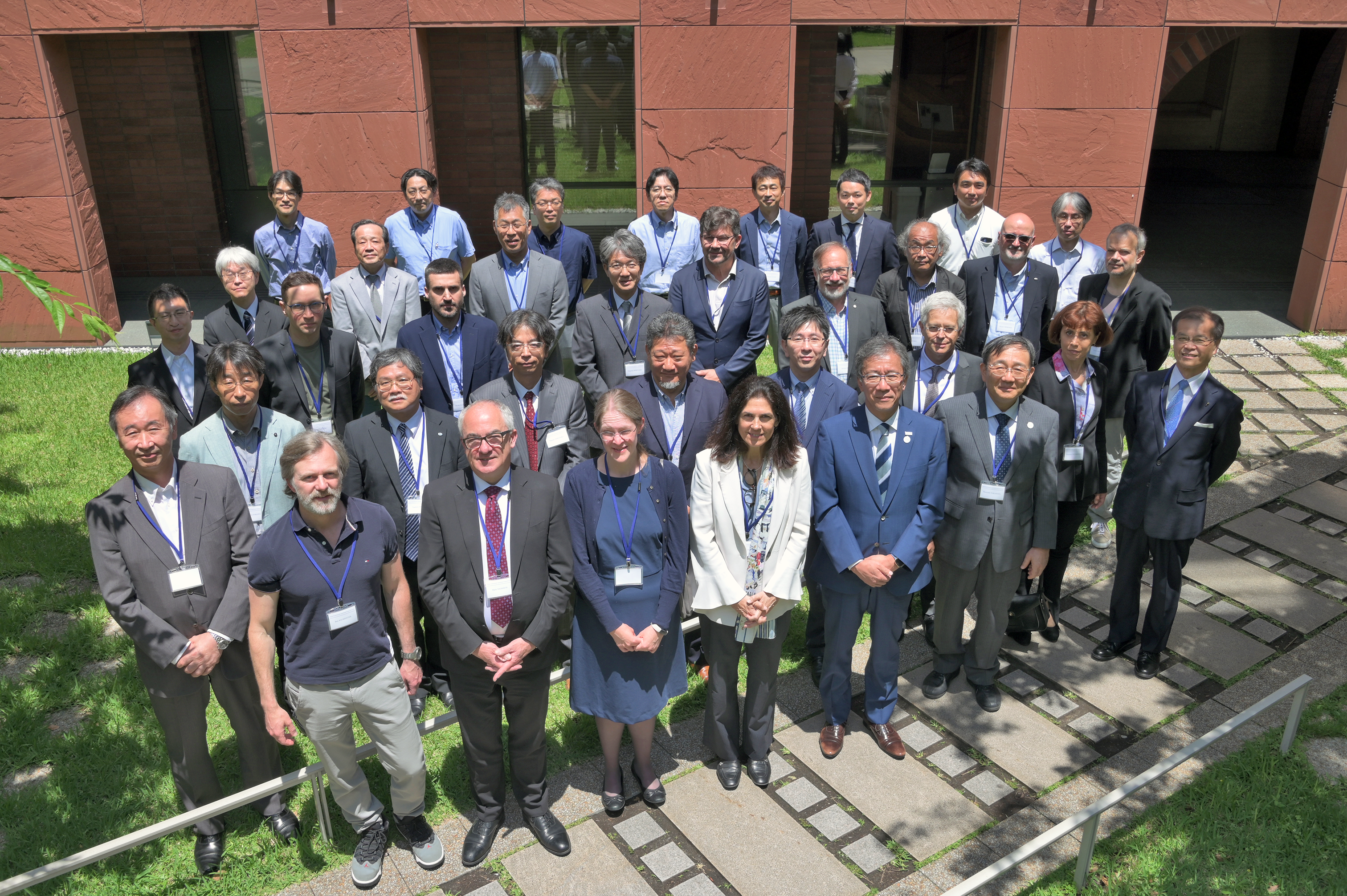
Forty members participated onsite in the 7th HKFF
Hyper-Kamiokande (HK) is a new world-leading international scientific research project aiming to elucidate the Grand Unified Theory and the history of the evolution of the universe through an investigation of proton decay and CP violation (the difference between neutrinos and antineutrinos), as well as the observation of neutrinos from supernova explosions. The HK detector will have a fiducial mass eight times larger than its predecessor, Super-Kamiokande, and is equipped with newly developed high-sensitivity photosensors. Furthermore, it is effectively combined with a neutrino beam produced by the high-power proton accelerator at the Japan Proton Accelerator Research Complex (J-PARC) in Tokai Village, Naka-gun, Ibaraki Prefecture. The budget for the HK construction was approved in the Japanese Diet in February 2020, which marked the official start of the project. The construction has gotten into full swing with the main cavern excavation, new photosensor production and upgrade of the high-power proton accelerator at J-PARC.
Furthermore, the budget proposals submitted by various countries, including Canada, Italy, South Korea, Morocco, Poland, Spain, Switzerland, and the UK, have been approved. Also, a memorandum of understanding (MoU) was concluded between the hosts and National Centre for Nuclear Research (NCBJ) in Poland in February 2022 and also between the hosts and the Ministry of Science and Innovation (MCIN) in Spain in August 2022.
The 7th HKFF meeting was held in a hybrid style at the Ito Hall of the International Ito Research Center. About 60 members (20 members online) discussed the project’s design, the current status of construction, and budget issues.
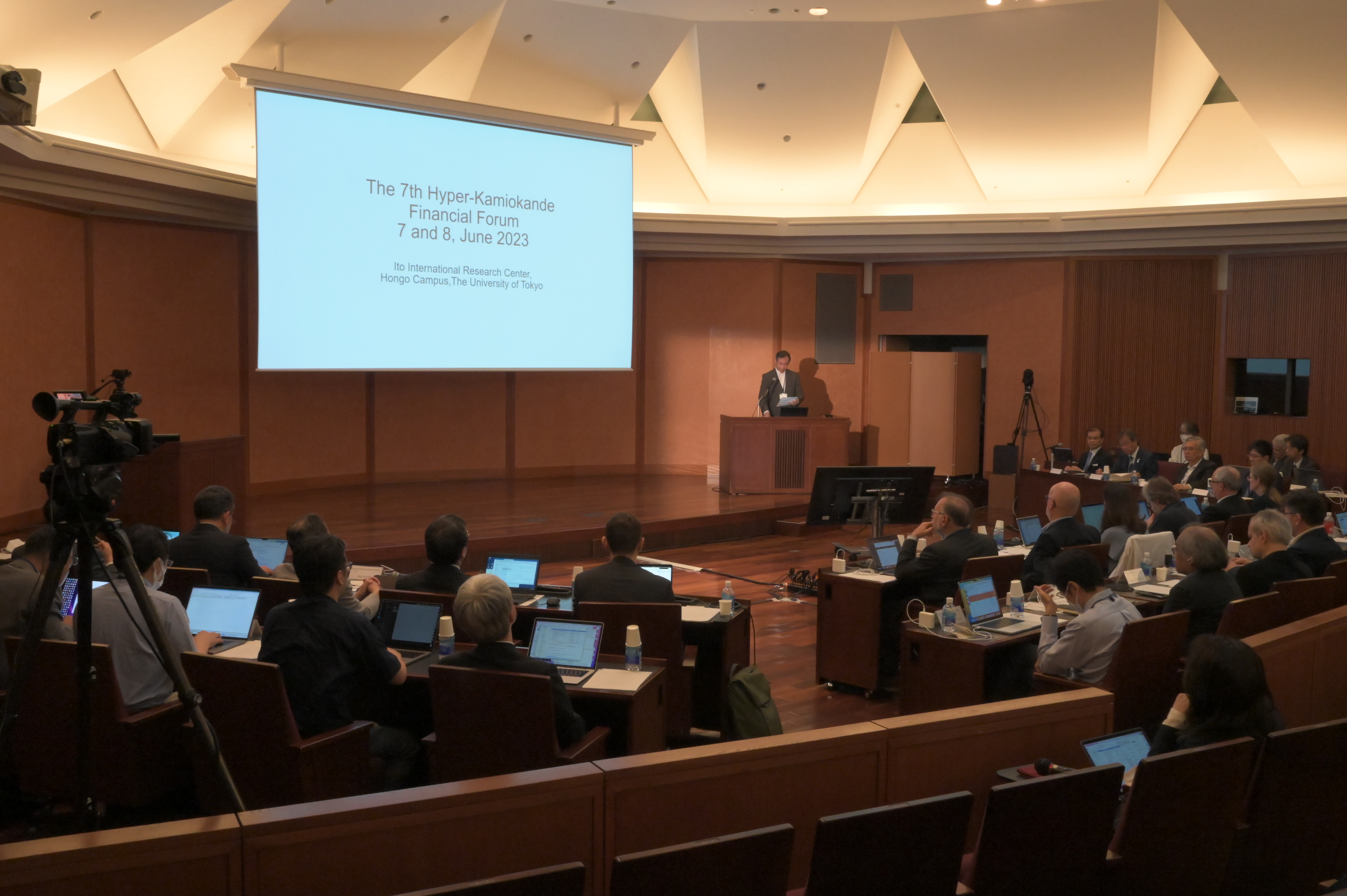
The 7th HKFF Meeting was held in Ito Hall, Hongo Campus, the University of Tokyo.
The meeting was opened with a welcome address from Prof. Takaaki Kajita, the director of the Next-generation Neutrino Science Organization (NNSO) of the University of Tokyo. Prof. Kajita told members, “The Hyper-Kamiokande Collaboration is now growing to more than 500 members from 21 countries, and cooperation with international partners is indispensable to build the best facility in the world. This time, we will share the current status of the project, have messages from representatives and discuss how to establish a strong international collaboration.” This was followed by a message by Prof. Teruo Fujii, President of the University of Tokyo: “The University of Tokyo administration has been working closely with MEXT to secure sufficient funding for Hyper-Kamiokande. ... UTokyo has also allocated 8.5 billion yen from our own funds for this project using the university bonds issued by us. ... However, discussions about how to share responsibilities among participating countries are still continuing regarding the outer detector system and part of the electronics system. I hope that those discussions can be concluded as soon as possible.” And another message followed from Prof. Masanori Yamauchi, Director General of High Energy Accelerator Research Organization (KEK): “KEK strongly promoted the upgrade of J-PARC Main Ring to increase the beam power 1.3MW and also contribute to timely construction of the Intermediate Water Cherenkov Detector (IWCD). We ask for your understanding and corporation so that neutrino scientists around the world can work together to create new scientific success.”
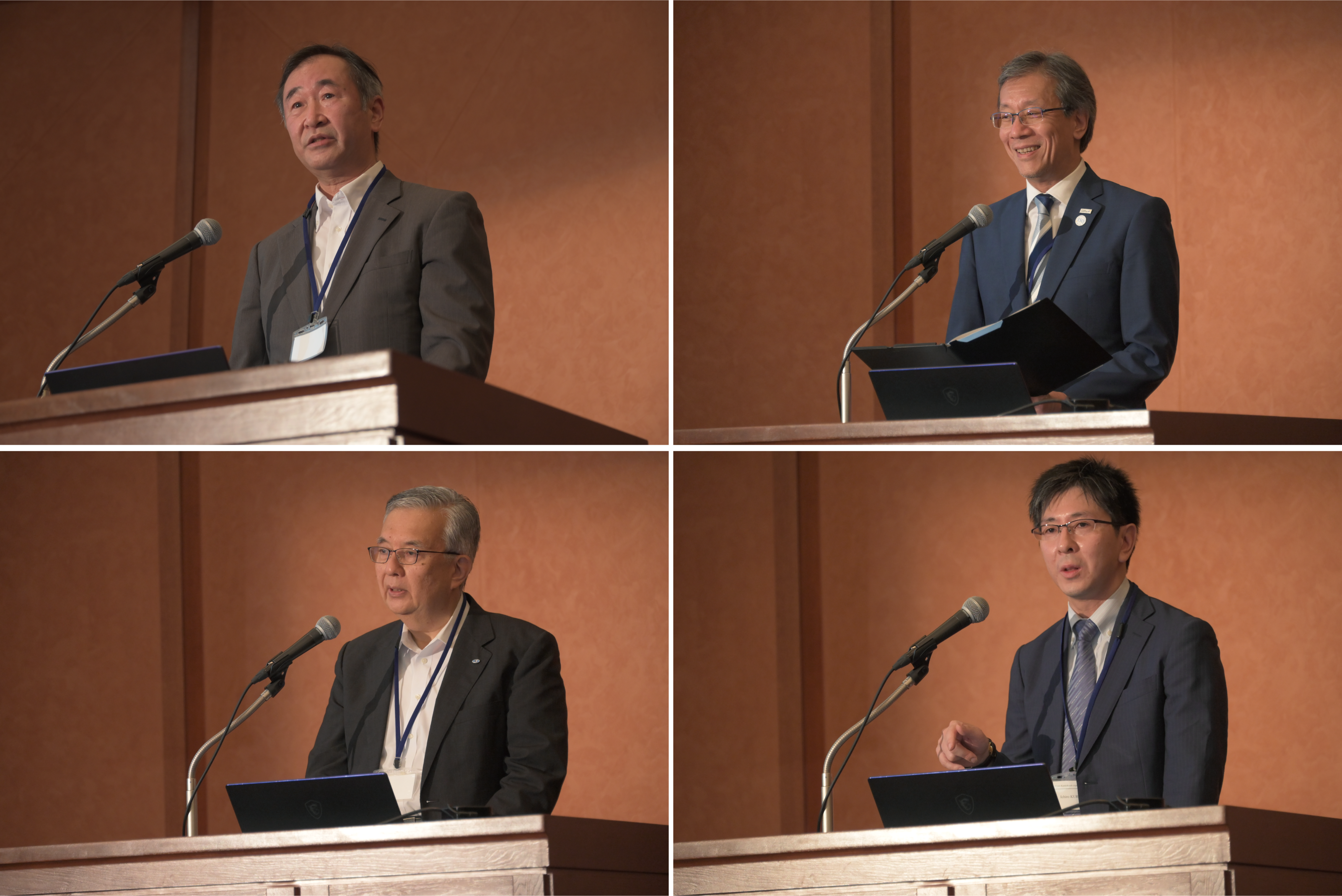
Prof. Kajita, NNSO director (top left), Prof. Fujii, President of the University of Tokyo (top right), Director Kuronuma from MEXT (bottom right), and Prof. Yamauchi, Director General of KEK (bottom left) in a clockwise direction.
Mr. Ichiro Kuronuma, Director of the University Research Facilitation Division, Research Promotion Bureau, the Ministry of Education, Culture, Sports, Science and Technology (MEXT), told HKFF members, “The Japanese government has already earmarked a total budget of approximately 20.6 billion yen and will continue to provide maximum support.” He expressed the necessity of strong international participation, saying, “We welcome that the host organizations have started preparing or signing MOUs with their collaborators as formal procedures to realize international contributions. We, MEXT, will also support the host organizations to implement this kind of procedure as smoothly as possible.”
After their messages, Prof. Masayuki Nakahata, the director of Institute for Cosmic Ray Research (ICRR), the University of Tokyo, reported the recent status of HK construction and MoUs concluded both with Poland and Spain. He explained that the construction of the experimental site was steadily in progress and, especially, excavation of the main cavern where the HK will be installed was started. Its upper dome diameter has reached 52 meters, beyond the 40-meter diameter of Super-Kamiokande (SK). After that, the current status of the budget plan for Hyper-Kamiokande was laid out by the spokespersons, Prof. Masato Shiozawa of the University of Tokyo and Prof. Francesca Di Lodovico from King’s College, London. They emphasized that it is critical that the cost and task sharing of the Outer Detector System, some of Readout Electronics and IWCD construction, be finalized as soon as possible, and asked for strong support from member countries.
Fourteen Countries Give Their Messages on Current Status
Following these presentations, the representatives from 14 countries: Armenia, Australia, Brazil, Canada, France, Italy, South Korea, Mexico, Morocco, Poland, Spain, Switzerland, the UK, and USA gave their messages, such as the number of researchers, confirmed budget and prospects for additional funding for the project.
This was followed by a discussion on how to allocate the budget to the needed components. They reached an agreement that the international partners will make their best effort to commit to key components as soon as possible and ideally by the end of 2023. On top of that, they agree with the importance of transitioning as soon as possible from the Financial Forum (HKFF) to the Funding Oversight Panel (HK-FOP), where sharing resources of the construction and operation among the funding agencies are to be determined. The first FOP meeting can be held this winter at the earliest.
Members Visit HK Construction Site in Kamioka
The next day, HKFF members made a trip to Kamioka-cho, Hida City, Gifu Prefecture, by Shinkansen and bus. They dropped by the ICRR Kamioka Observatory and received an overview of some of the research facilities in Kamioka from Prof. Nakahata, the director of ICRR, and an explanation about the HK construction on site by Prof. Shigetaka Moriyama, the project manager of HK. After that, they visited the construction site to observe the access tunnel and the upper dome of the main cavern where HK will be installed. Some members from foreign countries responded with gasps at the huge scale of the cavern.
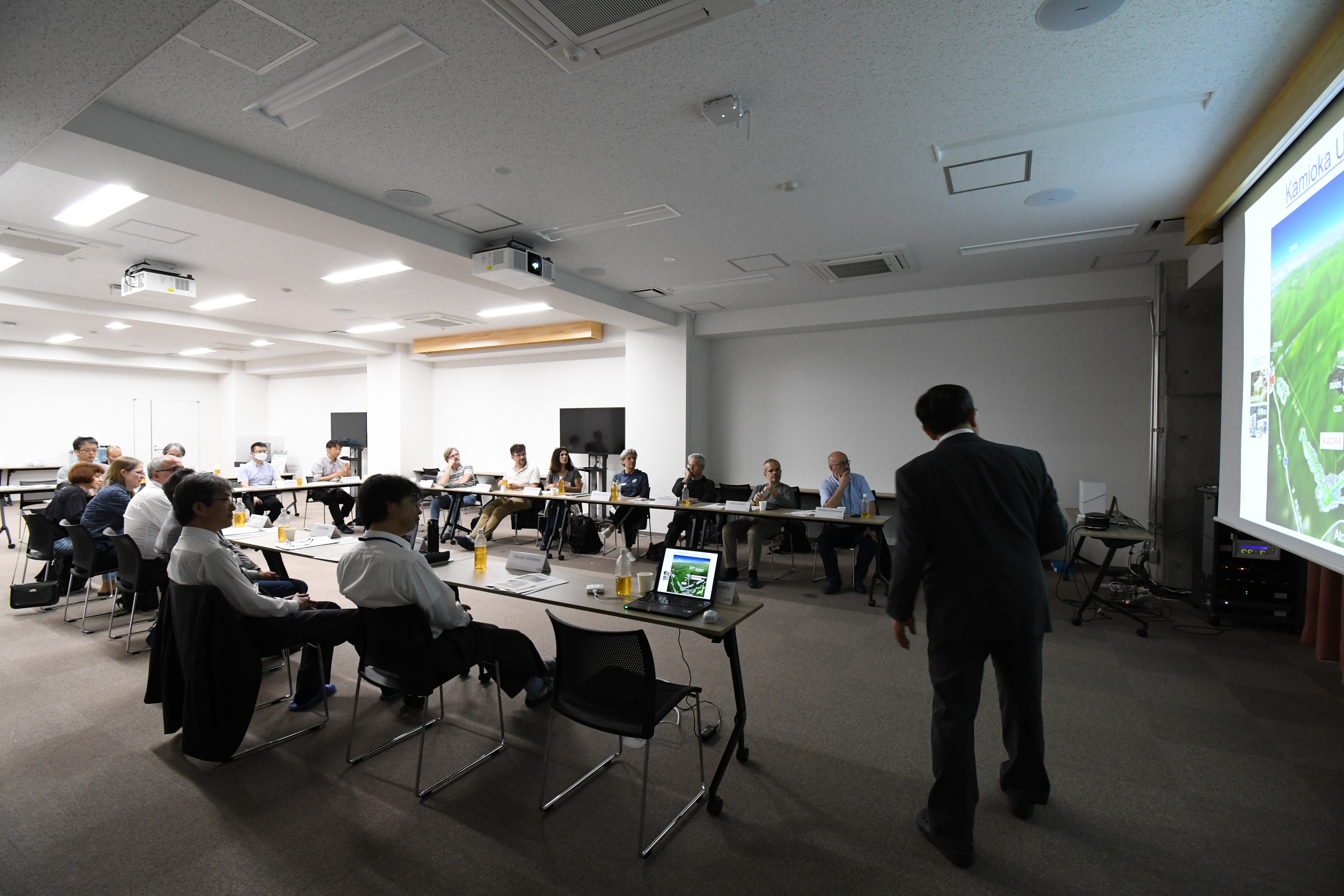
Presentation from Prof. Nakahata
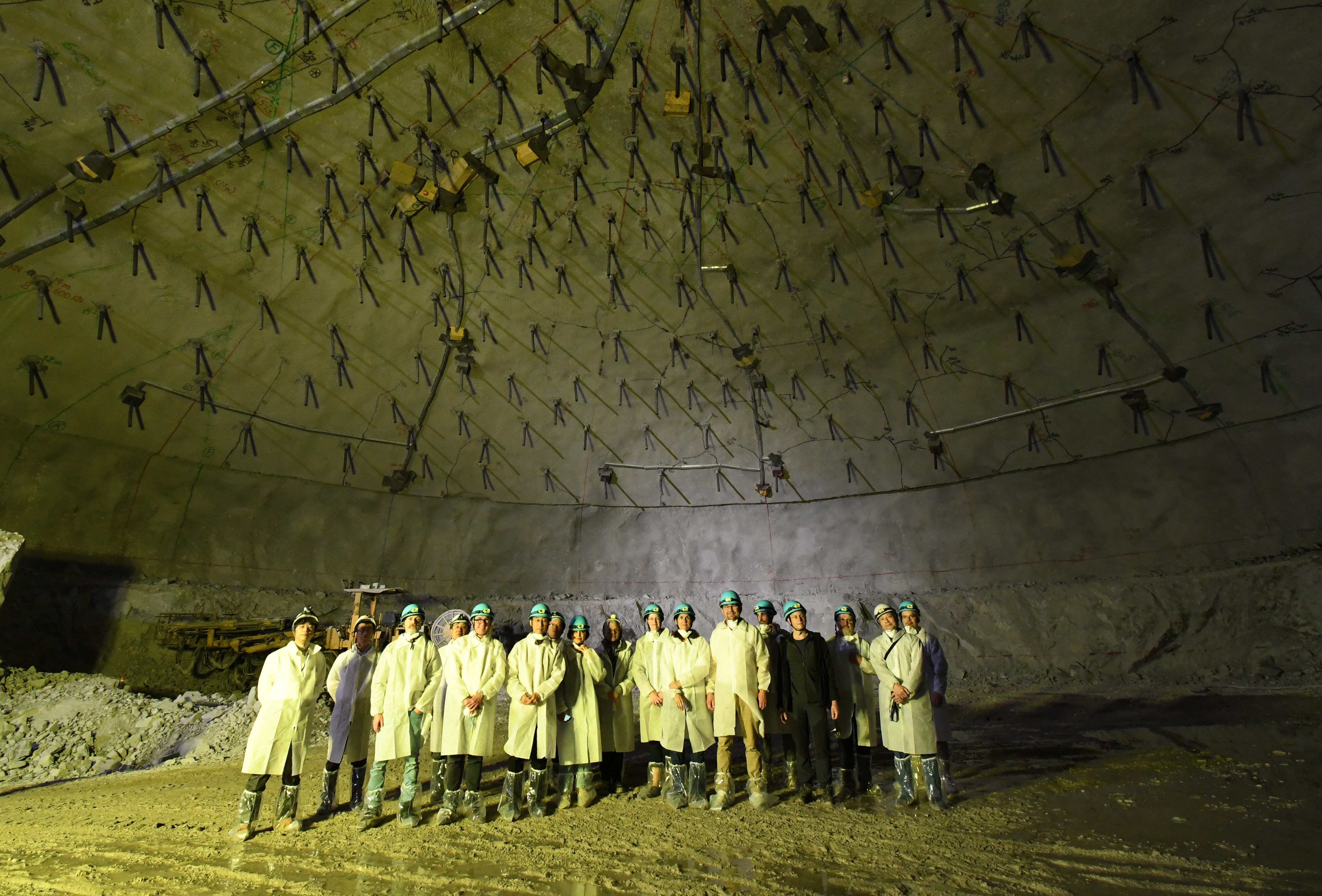
Observation of the main cavern of HK

Forty members participated onsite in the 7th HKFF
Hyper-Kamiokande (HK) is a new world-leading international scientific research project aiming to elucidate the Grand Unified Theory and the history of the evolution of the universe through an investigation of proton decay and CP violation (the difference between neutrinos and antineutrinos), as well as the observation of neutrinos from supernova explosions. The HK detector will have a fiducial mass eight times larger than its predecessor, Super-Kamiokande, and is equipped with newly developed high-sensitivity photosensors. Furthermore, it is effectively combined with a neutrino beam produced by the high-power proton accelerator at the Japan Proton Accelerator Research Complex (J-PARC) in Tokai Village, Naka-gun, Ibaraki Prefecture. The budget for the HK construction was approved in the Japanese Diet in February 2020, which marked the official start of the project. The construction has gotten into full swing with the main cavern excavation, new photosensor production and upgrade of the high-power proton accelerator at J-PARC.
Furthermore, the budget proposals submitted by various countries, including Canada, Italy, South Korea, Morocco, Poland, Spain, Switzerland, and the UK, have been approved. Also, a memorandum of understanding (MoU) was concluded between the hosts and National Centre for Nuclear Research (NCBJ) in Poland in February 2022 and also between the hosts and the Ministry of Science and Innovation (MCIN) in Spain in August 2022.
The 7th HKFF meeting was held in a hybrid style at the Ito Hall of the International Ito Research Center. About 60 members (20 members online) discussed the project’s design, the current status of construction, and budget issues.

The 7th HKFF Meeting was held in Ito Hall, Hongo Campus, the University of Tokyo.
The meeting was opened with a welcome address from Prof. Takaaki Kajita, the director of the Next-generation Neutrino Science Organization (NNSO) of the University of Tokyo. Prof. Kajita told members, “The Hyper-Kamiokande Collaboration is now growing to more than 500 members from 21 countries, and cooperation with international partners is indispensable to build the best facility in the world. This time, we will share the current status of the project, have messages from representatives and discuss how to establish a strong international collaboration.” This was followed by a message by Prof. Teruo Fujii, President of the University of Tokyo: “The University of Tokyo administration has been working closely with MEXT to secure sufficient funding for Hyper-Kamiokande. ... UTokyo has also allocated 8.5 billion yen from our own funds for this project using the university bonds issued by us. ... However, discussions about how to share responsibilities among participating countries are still continuing regarding the outer detector system and part of the electronics system. I hope that those discussions can be concluded as soon as possible.” And another message followed from Prof. Masanori Yamauchi, Director General of High Energy Accelerator Research Organization (KEK): “KEK strongly promoted the upgrade of J-PARC Main Ring to increase the beam power 1.3MW and also contribute to timely construction of the Intermediate Water Cherenkov Detector (IWCD). We ask for your understanding and corporation so that neutrino scientists around the world can work together to create new scientific success.”

Prof. Kajita, NNSO director (top left), Prof. Fujii, President of the University of Tokyo (top right), Director Kuronuma from MEXT (bottom right), and Prof. Yamauchi, Director General of KEK (bottom left) in a clockwise direction.
Mr. Ichiro Kuronuma, Director of the University Research Facilitation Division, Research Promotion Bureau, the Ministry of Education, Culture, Sports, Science and Technology (MEXT), told HKFF members, “The Japanese government has already earmarked a total budget of approximately 20.6 billion yen and will continue to provide maximum support.” He expressed the necessity of strong international participation, saying, “We welcome that the host organizations have started preparing or signing MOUs with their collaborators as formal procedures to realize international contributions. We, MEXT, will also support the host organizations to implement this kind of procedure as smoothly as possible.”
After their messages, Prof. Masayuki Nakahata, the director of Institute for Cosmic Ray Research (ICRR), the University of Tokyo, reported the recent status of HK construction and MoUs concluded both with Poland and Spain. He explained that the construction of the experimental site was steadily in progress and, especially, excavation of the main cavern where the HK will be installed was started. Its upper dome diameter has reached 52 meters, beyond the 40-meter diameter of Super-Kamiokande (SK). After that, the current status of the budget plan for Hyper-Kamiokande was laid out by the spokespersons, Prof. Masato Shiozawa of the University of Tokyo and Prof. Francesca Di Lodovico from King’s College, London. They emphasized that it is critical that the cost and task sharing of the Outer Detector System, some of Readout Electronics and IWCD construction, be finalized as soon as possible, and asked for strong support from member countries.
Fourteen Countries Give Their Messages on Current Status
Following these presentations, the representatives from 14 countries: Armenia, Australia, Brazil, Canada, France, Italy, South Korea, Mexico, Morocco, Poland, Spain, Switzerland, the UK, and USA gave their messages, such as the number of researchers, confirmed budget and prospects for additional funding for the project.
This was followed by a discussion on how to allocate the budget to the needed components. They reached an agreement that the international partners will make their best effort to commit to key components as soon as possible and ideally by the end of 2023. On top of that, they agree with the importance of transitioning as soon as possible from the Financial Forum (HKFF) to the Funding Oversight Panel (HK-FOP), where sharing resources of the construction and operation among the funding agencies are to be determined. The first FOP meeting can be held this winter at the earliest.
Members Visit HK Construction Site in Kamioka
The next day, HKFF members made a trip to Kamioka-cho, Hida City, Gifu Prefecture, by Shinkansen and bus. They dropped by the ICRR Kamioka Observatory and received an overview of some of the research facilities in Kamioka from Prof. Nakahata, the director of ICRR, and an explanation about the HK construction on site by Prof. Shigetaka Moriyama, the project manager of HK. After that, they visited the construction site to observe the access tunnel and the upper dome of the main cavern where HK will be installed. Some members from foreign countries responded with gasps at the huge scale of the cavern.

Presentation from Prof. Nakahata

Observation of the main cavern of HK






